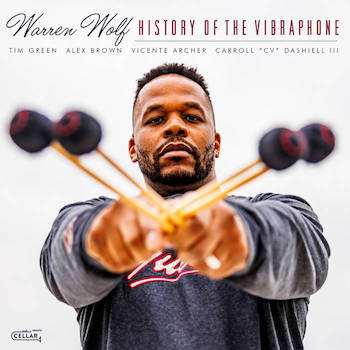Jazz Album Reviews: Vibraphone Madness — Patricia Brennan and Warren Wolf
By Steve Feeney
Two fine examples of musicians taking the vibraphone in and out.
Patricia Brennan Septet, Breaking Stretch (Pyroclastic Records)
Warren Wolf, History of the Vibraphone (Cellar Music Group)
There’s a lot of talk nowadays among jazz listeners about the choice of looking forward or looking backward. Two new releases may lead you to ask: Why not both?

Vibraphonist/marimbist Patricia Brennan lays it on pretty thick on Breaking Stretch, her latest release of original and impressively advanced compositions on the Pyroclastic label. Challenging layers of sound are on offer: to be immersed in and appreciated in multiple ways.
I’ve heard Brennan live and on recordings in small combo settings where she maintains a strong presence. But in this new septet release the Mexican-born, New York-based 30-something musician ups the ante considerably. Elements of jazz, classical, folk, and you-name-it-coexist on this recording, sometimes in harmony, but more often in a chafing superabundance of sound that is made to be confronted and ultimately, after some worthwhile effort, embraced.
In her notes, Brennan writes about creating a “broadness” on the disc through a rhythmic interplay of “depth through width, width through depth.” Indeed, the opening cut “Los Otros Yo (The Other Selves)” contains layers of percussion with bass and horns introducing the leader’s first solo against overlapping rhythms. There are hints of Thelonious Monk’s approach (“make the drummer sound good,” he once advised a band member) as well as Charles Mingus’s use of Mexican music. An intense mix of repetition and the free soloing is filtered throughout this remarkable piece.
Joining Brennan, who also dabbles in some electronics, are Jon Irabagon (alto and sopranino saxophones), Mark Shim (tenor saxophone), Adam O’ Farrill (trumpet with electronics), Marcus Gilmore (drums), Mauricio Herrera (percussion), and Kim Cass (bass).
A melody emerges amid the drifting percolation offered by the horns on the title piece. Irabagon solos with an urgency above Caribbean syncopations. But it’s Shim’s horn that supplies a dark romanticism. His solo on the somewhat analytical “555” also cuts through the chamber-like ambiance, as does O’Farrill’s electronic murmurs.
Cass opens “Palo de Oros (Suit of Coins)” with a closeup solo before an agitated collective following a minimalist line intervenes. Irabagon’s sopranino squeals a bit before the leader demands a semblance of order. Electronics bend and shape “On Sueños de Coral Azul (Blue Coral Dreams)” as Brennan nostalgically reflects at a more relaxed tempo.
“Mudanza (States of Change)” gives the drummers a break as Brennan, on marimba, provides murky colors, stretching the harmonies between the horns. It’s a striking track that suggests, along with the album as a whole, that the composer has just begun her explorations.
 If your taste in vibes-centered jazz is more inclined toward the traditional, Warren Wolf’s latest disc, History of the Vibraphone, will serve you well.
If your taste in vibes-centered jazz is more inclined toward the traditional, Warren Wolf’s latest disc, History of the Vibraphone, will serve you well.
The 44-year-old Berklee College of Music alum and former faculty member has assembled a quintet filled out by Tim Green (sax), Alex Brown (piano), Vicente Archer (bass), and Carroll “CV” Dashiell III (drums) for a session that highlights the music of past vibes masters like Lionel Hampton, Roy Ayers, Bobby Hutcherson, and several others (no women included).
Wolf loosens up with a rapid-fire run through Terry Gibbs’s “Bopsticle Course,” a piece that quickly confirms the band is up and at ’em. A few cuts later, we have Bobby Hutcherson’s “Herzog,” a post-bop nugget that allows Green, as well as the leader, to establish his chops.
Moving chronologically forward, Wolf charges into Chick Corea’s “Captain Señor Mouse.” Corea, who sometimes doubled on marimba, created a musical chase for the ages when he dueted with Gary Burton in an early version of this now classic number. Here, Wolf and Brown set up the unison dynamics before the band joins in for variations that relax things, just a little.
A couple of tunes here may sway toward easy listening. But the high points on this disc outweigh any quibbles about a pleasant and spirited survey program that, coupled with the much more adventurous Brennan disc, supply plenty of mighty good vibrations.
Steve Feeney is a Maine native and attended schools in Maine, New Hampshire, and Massachusetts. He has a Master of Arts degree in American and New England Studies from the University of Southern Maine. He began reviewing music on a freelance basis for the Portland Press Herald/Maine Sunday Telegram in 1995. He was later asked to also review theater and dance. Recently, he has added BroadwayWorld.com as an outlet and is pleased to now contribute to Arts Fuse.
Tagged: Breaking Stretch, History of the Vibraphone, Patricia Brennan Septet
